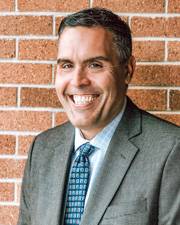
District Photo
A bomb threat about a school bus in Batavia and a threat to “shoot up a school,” causing a lockout in all Genesee County schools.
Both of those incidents happened in just the last three weeks, and although — thankfully — they were found not to be credible — both were threats of violence involving school children and personnel. Each one stemmed from a call within the City of Batavia, and subsequent investigations found the suspects to be juveniles.
Are they harmless pranks? Can anything with such violence attached — a bomb on a school bus and shooting up a school — be considered harmless? The Batavian reached out to Superintendent Jason Smith to find out what the city school district is doing proactively in light of these recent and potentially increasing threats.
Is the city school district treating students and school bus transportation any differently, any more cautiously, given this and other recent threats -- real or not -- against district students and/or personnel?
“We have a very trusting relationship with STA, our transportation provider, and will continue to rely on that relationship to keep our students safe,” Smith said. “We also have the same relationship with the Batavia Police Department, and this, again, is integral in our successful open, transparent, and real-time communication.
“We continue to remind the entire Batavia community to please report any suspicious behavior, as we appreciate the call received from this most recent threat found to be not credible.”
That call came from a local business that received a call from “what was believed to be a juvenile stating there was a bomb on a school bus” at a location in the City of Batavia, according to Batavia Police Tuesday.
The city school district hired an additional school resource officer this past year -- a cost of approximately $100,000 per officer for salary and benefits -- making it two officers for the district. At the time, shootings in other parts of the country, Texas being one, were named as reasons for bringing more security on board at the district.
Are School Resource Officers being put to use in any different way given these threats -- Are they more visible? Going on bus rides with students? Are you having increased school assemblies, reminders, precautions within the district?
“Our SROs will be deployed when and where needed, which could include visibility as needed on our school buses,” Smith said.
While these threats have so far been found to be false, how do you move forward and not treat them all with a "crying wolf" mentality so as not to overlook the one that might actually be real one day?
“We will never treat a threat as ‘crying wolf,’ we will continue to rely on the experts at the Batavia Police Department to investigate these threats, and they will be prosecuted to the fullest extent possible, and our Code of Conduct will be followed,” Smith said.
The city school district has increased its number of counselors available for students, spurred by post-COVID funding and the perceived effects of pandemic protocols on student learning and emotional impacts.
Are you ramping up counseling to try and detect any troubled kids that might be on the edge of a really bad day? What do you look for? How do you react?
“We have an outstanding counseling team, and our Counseling Department Chairperson just updated the Board at our meeting on Monday night. We have a comprehensive counseling plan, a crisis intervention protocol, relationships with outside mental health providers and therapists, school social workers, etc., that all work as a team to provide support to our students and families,” he said. “Our reaction ranges from a variety of steps: calmly, immediately, swiftly, thoughtful, transparently, and/or communicative with relevant parties and stakeholders.
“Since mental health has gained more attention, yes, our counseling team and administration has indeed ramped up efforts to detect and respond to children in need.”
Monday was Batavia’s Board of Education meeting, and Counseling Department Chair Sherry Crumity presented an update of how the department has been working with students and the various programs being integrated within all grade levels.

District Photo
“It’s been a busy year for counselors this year, but it’s been well worth it,” Crumity said.
Her material is based on a couple of components, including the American School Counselors Association, which provides a national model of school counseling programs to improve student outcomes.
This includes areas of academic performance, attendance, threats, and suicide; disciplinary measures; creating regular assessments to “keep our fingers on the pulse of student needs,” and to boil much of it down: “going back to the basics of learning,” Crumity said.
“The last report we got from them on a state level and through the Counseling Association is that mental health needs in schools are up 52 percent. And that's why we see so much increased funding. So counselors’ roles are definitely changing. We're collaborating more now than the teacher, with outside agencies to help us with different things,” Crumity said. “You're definitely playing a more critical role in social-emotional learning. With COVID, we sort of increased it. But I think now we're kind of really seeing the impacts of students returning to school. So counselors have definitely stepped up to the plate, and sort of navigated whether it's small counseling, large group counseling, individual counseling, meeting with parents more on a regular basis, and definitely expanding our social-emotional activities throughout the building.
“Other counselor roles, definitely, you know, academic achievement strategies, we're working with expanding different academic interventions throughout our buildings for their enrichment activities, activities for students who may have had that gap in learning during COVID,” she said.
Increased programs have meant wellness activities, holiday theme weeks, kindness month, spirit weeks, mix it up days — during which kids will sit with others they don’t typically socialize with during lunchtime to try and avoid the clique atmosphere — student/parent newsletters, peace circles and family nights.
There are four goals, with the first one focusing on social-emotional learning, positive behavior and intervention systems, having alternatives to suspensions to keep kids in school, bullying prevention and inviting student/parent/teacher feedback, according to Crumity’s materials.
Attendance is such an important factor in educational success, that there are three tiers for absenteeism: encouraging better attendance and explaining the importance of why students need to be in school; the second tier is designed to remove any barriers that may be keeping kids home and out of school; and the third is a more intense strategy for those that miss at least 20 percent or more school during the year and it has been found they benefit from a stronger level of support, she said.
“We like to promote healthy relevant teaching models,” she said. “And we're just looking at how to fine-tune the action plan and report more efficiently so that we can see on a regular basis if it's working, and if it's not working.”
Do you feel you're doing everything possible, or does more still need to be done?
“Until the threats stop, more always needs to be done,” Smith said. “We continue to need and rely on the support of families, community agencies, law enforcement, and our BCSD staff, and I will personally continue to provide information and updates to our community, families and staff in a timely and transparent manner.”
